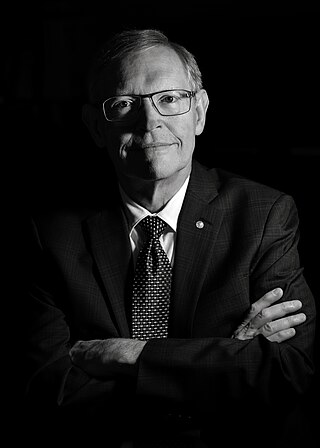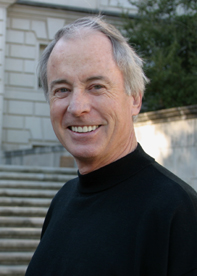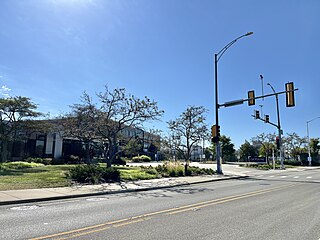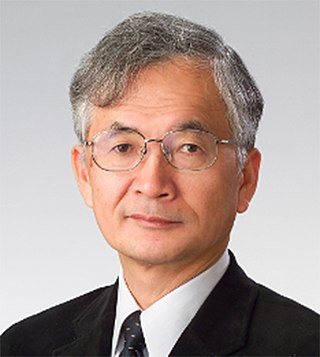
Porphyrins are a group of heterocyclic, macrocyclic, organic compounds, composed of four modified pyrrole subunits interconnected at their α carbon atoms via methine bridges. In vertebrates, an essential member of the porphyrin group is heme, which is a component of hemoproteins, whose functions include carrying oxygen in the bloodstream. In plants, an essential porphyrin derivative is chlorophyll, which is involved in light harvesting and electron transfer in photosynthesis.

Henry Frederick "Fritz" Schaefer III is an American computational, physical, and theoretical chemist.

Roy F. Schwitters was an American physicist, professor of physics at Harvard, Stanford, and finally the University of Texas at Austin. He was also director of the Superconducting Super Collider between 1989 and 1993.

Texaphyrin is a sub-class of heterocyclic macrocycle molecules known as porphyrins. The molecule was invented by University of Texas at Austin professor Jonathan Sessler. The name texaphyrin arose because some of the molecules have a shape that can superimpose onto the points of the star featured on the state flag of Texas. Texaphyrins were nominated as the "State Molecule of Texas", but the buckyball was chosen instead.

Stuart Schreiber is an American chemist who is the Morris Loeb Research Professor at Harvard University, a co-founder of the Broad Institute, Howard Hughes Medical Institute Investigator, Emeritus, and a member of the National Academy of Sciences and National Academy of Medicine. He currently leads Arena BioWorks.

William Esco Moerner, also known as W. E. Moerner, is an American physical chemist and chemical physicist with current work in the biophysics and imaging of single molecules. He is credited with achieving the first optical detection and spectroscopy of a single molecule in condensed phases, along with his postdoc, Lothar Kador. Optical study of single molecules has subsequently become a widely used single-molecule experiment in chemistry, physics and biology. In 2014, he was awarded the Nobel Prize in Chemistry.

Carolyn Ruth Bertozzi is an American chemist and Nobel laureate, known for her wide-ranging work spanning both chemistry and biology. She coined the term "bioorthogonal chemistry" for chemical reactions compatible with living systems. Her recent efforts include synthesis of chemical tools to study cell surface sugars called glycans and how they affect diseases such as cancer, inflammation, and viral infections like COVID-19. At Stanford University, she holds the Anne T. and Robert M. Bass Professorship in the School of Humanities and Sciences. Bertozzi is also an Investigator at the Howard Hughes Medical Institute (HHMI) and is the former director of the Molecular Foundry, a nanoscience research center at Lawrence Berkeley National Laboratory.

Stephen F. Martin is an American chemist and professor of chemistry at The University of Texas at Austin. He is the M. June and J. Virgil Waggoner Regents Chair in Chemistry.
Harden M. McConnell was an American physical chemist. His many awards included the National Medal of Science and the Wolf Prize, and he was elected to the National Academy of Science."

Allen Joseph Bard was an American chemist. He was the Hackerman-Welch Regents Chair Professor and director of the Center for Electrochemistry at the University of Texas at Austin. Bard developed innovations such as the scanning electrochemical microscope, his co-discovery of electrochemiluminescence, his key contributions to photoelectrochemistry of semiconductor electrodes, and co-authoring a seminal textbook.
Paul Frank Barbara was an American chemist. His research interests focused on the understanding of the molecular structure and dynamics of complex chemical systems, including organic semi-conductors for photovoltaic applications, proton and electron transfer reactions, the hydrated electron and intermediates in the reverse transcription mechanism of HIV-1. His laboratory developed and applied novel ultrafast and single molecule spectroscopies to study the complexity of these chemical system.

Ibrutinib, sold under the brand name Imbruvica among others, is a small molecule drug that inhibits B-cell proliferation and survival by irreversibly binding the protein Bruton's tyrosine kinase (BTK). Blocking BTK inhibits the B-cell receptor pathway, which is often aberrantly active in B cell cancers. Ibrutinib is therefore used to treat such cancers, including mantle cell lymphoma, chronic lymphocytic leukemia, and Waldenström's macroglobulinemia. Ibrutinib also binds to C-terminal Src Kinases. These are off-target receptors for the BTK inhibitor. Ibrutinib binds to these receptors and inhibits the kinase from promoting cell differentiation and growth. This leads to many different side effects like left atrial enlargement and atrial fibrillation during the treatment of Chronic Lymphocytic Leukemia.

AbbVie Inc. is an American pharmaceutical company headquartered in North Chicago, Illinois. It is ranked sixth on the list of largest biomedical companies by revenue. In 2023, the company's seat in Forbes Global 2000 was 74, and rank 89 on the 2024 list. The company's primary product is Humira (adalimumab), administered via injection. It is approved to treat autoimmune diseases including rheumatoid arthritis, Crohn's disease, plaque psoriasis, and ulcerative colitis.
Craig M. Crews is an American scientist at Yale University known for his contributions to chemical biology. He is known for his contributions to the field of induced proximity through his work in creating heterobifunctional molecules that "hijack" cellular processes by inducing the interaction of two proteins inside a living cell. His initial work focused on the discovery of PROteolysis-TArgeting Chimeras (PROTACs) to trigger degradation of disease-causing proteins, a process known as targeted protein degradation (TPD), and he has since developed new versions of -TACs to leverage other cellular processes and protein families to treat disease.
Livia Schiavinato Eberlin is a Brazilian analytical chemist who won a MacArthur "Genius" Fellowship for her research on the use of mass spectrometry to detect cancerous tissue.
Bruce C. Gibb is a professor of chemistry at Tulane University. He is notable for his work in aqueous supramolecular chemistry, with particular emphasis on self-assembly leading to compartmentalization, and contributing to fundamental understandings of the hydrophobic effect and Hofmeister effect Bruce C. Gibb received both his B.Sc. (1987) and Ph.D. degrees (1992) from Robert Gordon University. His Ph.D. Synthesis and Structural Examination of 3a,5-cyclo-5a-Androstane Steroids was carried out under the direction of Philip J. Cox and Steve M. MacManus. He accepted a gratis appointment as a post-doctoral researcher with John Sherman at the University of British Columbia (UBC) in 1993 where he "discovered" his interest in supramolecular chemistry. He worked at UBC through 1994, and subsequently as a post-doctoral researcher with James Canary at New York University from 1994-1996.
Michael J. Therien is the William R. Kenan, Jr. Professor of Chemistry at Duke University.

Atsuhiro Osuka is a research professor of organic chemistry in the Department of Chemistry, Graduate School of Science, Kyoto University (Japan). He is recognized in the fields of porphyrinoid chemistry for his works in extended π-electron systems and its tunable aromatic behaviors.
Jason Ben Shear is an American chemist and expert in biomaterials and bioengineering. He is currently Professor of Chemistry at the University of Texas at Austin. Shear has been considered one of the pioneers of two-photon photolithography.
Amanda E. Hargrove is a chemist and professor at Duke University. Hargrove is also the editor-in-chief of Medicinal Research Reviews, and a member of the Scientific Advisory Board of Arrakis Therapeutics. At Duke University, Hargrove directs an interdisciplinary research program in chemical biology that focuses on harnessing the specific interactions between small molecules and RNA, and using those RNA-small molecule interactions to probe the structure, and function of RNA. The long-term goal of the group's research is to identify specific molecule-RNA interactions that may have therapeutic potential in the treatment of viral infection and human disease. She has received numerous awards for her scientific research, teaching, and service in support of diversity, equity, and inclusion.













